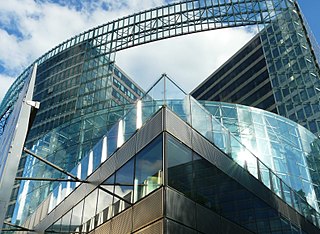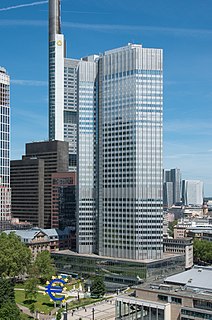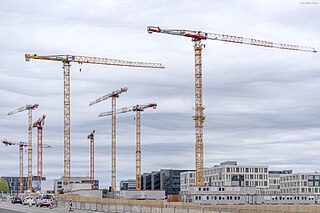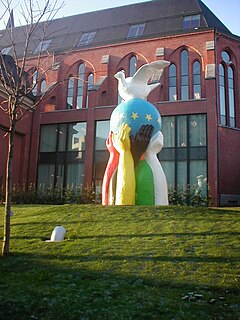 W
WThe Berlaymont is an office building in Brussels, Belgium, which houses the headquarters of the European Commission, the executive branch of the European Union (EU). The structure is located at Schuman roundabout at 200, Rue de la Loi/Wetstraat, in what is known as the "European Quarter". The unique form of the Berlaymont's architecture is used in the European Commission's official emblem.
 W
WThe Breydel building is an office block in the European Quarter of Brussels (Belgium) that served as a temporary headquarters for the European Commission between 1991 and 2004.
 W
WThe Charlemagne building is a high-rise in the European Quarter of Brussels, which houses the Directorate-General for Economic and Financial Affairs, the Directorate-General for Trade and, since 2015, the Internal Audit Service of the Commission.
 W
WThe Convent Van Maerlant is a former convent which consists of a church and the Chapel of the Resurrection on Rue Van Maerlant/Van Maerlantstraat in Brussels, Belgium. Jacob van Maerlant was a famous medieval Flemish poet.
 W
WThe Jacques Delors building, at 99-101 rue Belliard in the European Quarter of Brussels, houses the European Economic and Social Committee and the Committee of the Regions.
 W
WThe Espace Léopold or Leopoldruimte is the complex of parliament buildings in Brussels (Belgium) housing the European Parliament, a legislative chamber of the European Union.
 W
WThe Europa building is the seat of the European Council and Council of the European Union, located on Wetstraat/Rue de la Loi in the European Quarter of Brussels, the capital city of Belgium. Its defining feature is the multi-storey "lantern-shaped" construct holding the main meeting rooms; a representation of which has been adopted by both the European Council and Council of the EU as their official emblems. The Europa building is situated on the former site of the partially demolished and renovated Bloc A of the Résidence Palace. Its exterior combines the listed Art Deco façade of the original 1920s building with the contemporary design of architect Philippe Samyn. The building is linked via two skyways and a service tunnel to the adjacent Justus Lipsius building, which provides for additional office space, meeting rooms and press facilities.
 W
WEurotower is a 40-storey, 148 m (486 ft) skyscraper in the Innenstadt district of Frankfurt, Germany. The building served as the seat of the European Central Bank (ECB) until 18 March 2015, at which point it was officially replaced by a new purpose-built building. It now hosts the European Central Bank's Single Supervisory Mechanism.
 W
WThe Jean Monnet 2 building is a future office complex for the European Commission under construction on Boulevard Konrad Adenauer in the European district of the Luxembourg City quarter of Kirchberg, Luxembourg. The complex is to be composed of a welcome pavilion and two office buildings to be completed in two phases respectively; an 8 storey 180 metre (m) long block and a 24 storey tower, connected at the basement and second storey levels. The first phase is expected to be completed by late February 2023, and the second phase by late February 2024. The first Jean Monnet building, opened in 1975, was demolished between 2016 and 2019, after exceeding its lifespan, and following the discovery of airborne traces of asbestos. The construction site combines some of the plot of the previous building with an adjacent former open air car park. Upon completion, the Jean Monnet 2 building will enable the European Commission to consolidate the majority of its Luxembourg-based staff on one site. Like its predecessor, the building's namesake is European Union (EU) founding father Jean Monnet.
 W
WThe Justus Lipsius building, located in Brussels, Belgium, was the headquarters of the Council of the European Union from 1995, and the de facto home of the European Council from 2002, until their relocation to the adjacent newly constructed Europa building at the beginning of 2017. The building, which has a gross surface area of 227,278 m2, still provides for additional meeting rooms, office space and press facilities for both institutions. It consists of 17 conference rooms with at least 10 interpretation booths each, 5 other meeting rooms and 2 rooms for official meals. It also provides 40,048 m2 of offices for both institutions' shared General Secretariat. An onsite press centre is also featured, which can be extended during summits with up to 600 seats in the atrium. It is linked, via means of two skyways and a service tunnel, to the Europa building.
 W
WThe Kirchberg District Centre is a mixed-use building complex in northeastern Kirchberg, Luxembourg City, Luxembourg containing both an office complex and shopping mall, with their principal tenants respectively being the European Commission's statistical office, Eurostat, and an Auchan hypermarket. Those parts of the building dedicated to office use are collectively referred to as the "Joseph Bech building", after European Union (EU) pioneer and former Luxembourg prime minister, Joseph Bech. The complex's shopping gallery is referred to as the "Kirchberg Shopping Centre".
 W
WThe Lex building is a high-rise of government offices in the European Quarter of Brussels (Belgium). It is an annex building of the Council of the European Union and is located at Rue de la Loi/Wetstraat 145.
 W
WMadou Plaza Tower is a high-rise building in Brussels (Belgium). It was built in 1965 and renovated between 2002 and 2006 and taken over by the European Commission. It is located on the Small Ring, in the municipality of Saint-Josse-ten-Noode, at 1 Place Madouplein. It hosts the commission's Directorate-General for Competition.
 W
WThe Palais de la Cour de Justice is a building complex acting as the seat of the Court of Justice of the European Union (CJEU), located in the European district of the Luxembourg City quarter of Kirchberg. Today the Palais complex encompasses the original 1973 building, now known as the Ancien Palais, which houses the court rooms of the CJEU's Court of Justice, the Anneau building, encircling the Ancien Palais, which contains the judges chambers and deliberative rooms, the three tower buildings containing the CJEU's translation services, and the Gallery building, containing the CJEU's legal library and linking all the structures of the Palais complex with the renovated three annexes originally constructed between 1978 and 1994 that now host the court rooms of the CJEU's General Court.
 W
WThe regional representation of the European Commission in Bonn is part of the Commission representation in Germany. The main office is located in Berlin and another regional representation is in Munich. Jochen Pöttgen has been heading the regional representation in Bonn since 2014, whereas Richard Kühnel leads the Commission representation office in Berlin.
 W
WThe Representation of the European Commission in Germany is a representation of the European Commission with the head office located in Berlin. There are two more regional representation offices in Bonn and Munich. Jörg Wojahn is in charge of the representations in Germany since 1 September 2019, who was responsible of the representation office in Austria.
 W
WThe seat of the European Central Bank (ECB) is an office building complex in Frankfurt, Germany. It comprises a twin-tower skyscraper and the former Wholesale Market Hall (Großmarkthalle), with a low-rise building connecting the two. It was completed in 2014 and was officially opened on 18 March 2015.
 W
WThe city of Strasbourg in France is the official seat of the European Parliament. The institution is legally bound by the decision of Edinburgh European Council of 11 and 12 December 1992 and Article 341 of the TFEU to meet there twelve times a year for a session, each of which usually takes about four days. The majority of work, however, takes place in Brussels, and some other work is undertaken in Luxembourg City. Also all votes of the European Parliament must take place in Strasbourg. "Additional" sessions and committees take place in Brussels. Although de facto a majority of the Parliament's work is now geared to its Brussels site, it is legally bound to keep Strasbourg as its official home; a situation which garners much criticism from the European Parliament itself, as well as many interest groups, administrative staff, and environmentalist groups amongst others.
 W
WThe Statue of Europe is a sculpture symbolising peace through European integration, while at the same time aiming to demonstrate the motto of the European Union (EU), "United in Diversity". It is located in the garden of Convent Van Maerlant in the crossroads of the street Van Maerlant and "chaussée d'Etterbeek", in the European Quarter of Brussels, Belgium. Made out of resin, the statue measures more than 5 meters and weighs nearly 800 kg. It was inaugurated on 9 December 2003 by Neil Kinnock and Viviane Reding, who respectively were Vice-President of the European Commission and Commissioner for Culture at the time. 2003 was the European Year of People with Disabilities, and the Eastern enlargement of the EU was awaited.